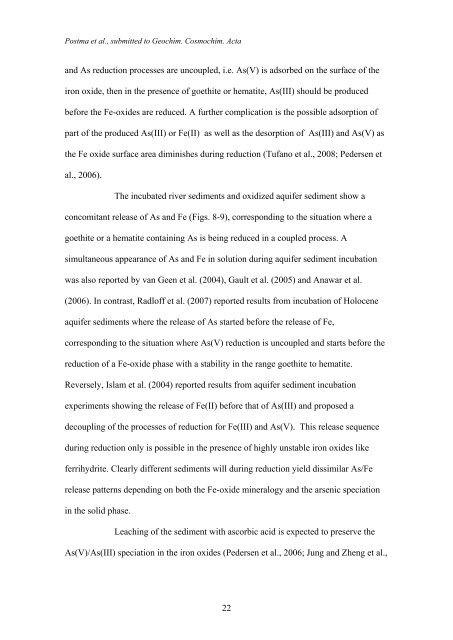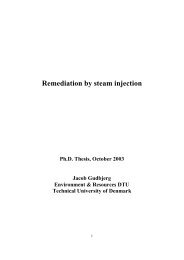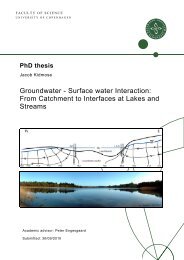Groundwater arsenic in the Red River delta, Vietnam ... - Fiva
Groundwater arsenic in the Red River delta, Vietnam ... - Fiva
Groundwater arsenic in the Red River delta, Vietnam ... - Fiva
Create successful ePaper yourself
Turn your PDF publications into a flip-book with our unique Google optimized e-Paper software.
Postma et al., submitted to Geochim. Cosmochim. Acta<br />
and As reduction processes are uncoupled, i.e. As(V) is adsorbed on <strong>the</strong> surface of <strong>the</strong><br />
iron oxide, <strong>the</strong>n <strong>in</strong> <strong>the</strong> presence of goethite or hematite, As(III) should be produced<br />
before <strong>the</strong> Fe-oxides are reduced. A fur<strong>the</strong>r complication is <strong>the</strong> possible adsorption of<br />
part of <strong>the</strong> produced As(III) or Fe(II) as well as <strong>the</strong> desorption of As(III) and As(V) as<br />
<strong>the</strong> Fe oxide surface area dim<strong>in</strong>ishes dur<strong>in</strong>g reduction (Tufano et al., 2008; Pedersen et<br />
al., 2006).<br />
The <strong>in</strong>cubated river sediments and oxidized aquifer sediment show a<br />
concomitant release of As and Fe (Figs. 8-9), correspond<strong>in</strong>g to <strong>the</strong> situation where a<br />
goethite or a hematite conta<strong>in</strong><strong>in</strong>g As is be<strong>in</strong>g reduced <strong>in</strong> a coupled process. A<br />
simultaneous appearance of As and Fe <strong>in</strong> solution dur<strong>in</strong>g aquifer sediment <strong>in</strong>cubation<br />
was also reported by van Geen et al. (2004), Gault et al. (2005) and Anawar et al.<br />
(2006). In contrast, Radloff et al. (2007) reported results from <strong>in</strong>cubation of Holocene<br />
aquifer sediments where <strong>the</strong> release of As started before <strong>the</strong> release of Fe,<br />
correspond<strong>in</strong>g to <strong>the</strong> situation where As(V) reduction is uncoupled and starts before <strong>the</strong><br />
reduction of a Fe-oxide phase with a stability <strong>in</strong> <strong>the</strong> range goethite to hematite.<br />
Reversely, Islam et al. (2004) reported results from aquifer sediment <strong>in</strong>cubation<br />
experiments show<strong>in</strong>g <strong>the</strong> release of Fe(II) before that of As(III) and proposed a<br />
decoupl<strong>in</strong>g of <strong>the</strong> processes of reduction for Fe(III) and As(V). This release sequence<br />
dur<strong>in</strong>g reduction only is possible <strong>in</strong> <strong>the</strong> presence of highly unstable iron oxides like<br />
ferrihydrite. Clearly different sediments will dur<strong>in</strong>g reduction yield dissimilar As/Fe<br />
release patterns depend<strong>in</strong>g on both <strong>the</strong> Fe-oxide m<strong>in</strong>eralogy and <strong>the</strong> <strong>arsenic</strong> speciation<br />
<strong>in</strong> <strong>the</strong> solid phase.<br />
Leach<strong>in</strong>g of <strong>the</strong> sediment with ascorbic acid is expected to preserve <strong>the</strong><br />
As(V)/As(III) speciation <strong>in</strong> <strong>the</strong> iron oxides (Pedersen et al., 2006; Jung and Zheng et al.,<br />
22





